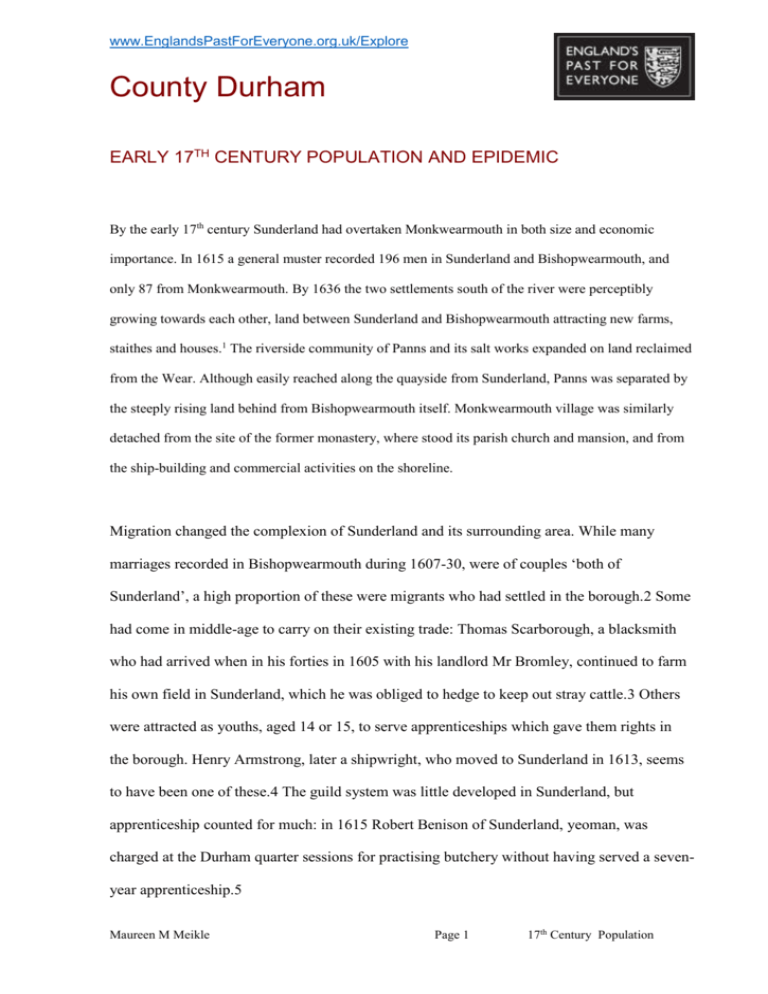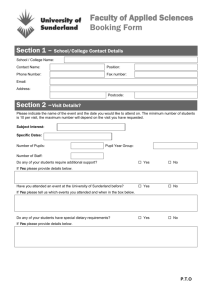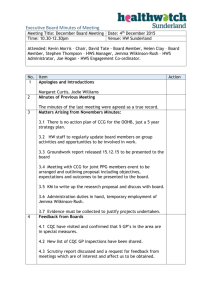file
advertisement

www.EnglandsPastForEveryone.org.uk/Explore County Durham EARLY 17TH CENTURY POPULATION AND EPIDEMIC By the early 17th century Sunderland had overtaken Monkwearmouth in both size and economic importance. In 1615 a general muster recorded 196 men in Sunderland and Bishopwearmouth, and only 87 from Monkwearmouth. By 1636 the two settlements south of the river were perceptibly growing towards each other, land between Sunderland and Bishopwearmouth attracting new farms, staithes and houses.1 The riverside community of Panns and its salt works expanded on land reclaimed from the Wear. Although easily reached along the quayside from Sunderland, Panns was separated by the steeply rising land behind from Bishopwearmouth itself. Monkwearmouth village was similarly detached from the site of the former monastery, where stood its parish church and mansion, and from the ship-building and commercial activities on the shoreline. Migration changed the complexion of Sunderland and its surrounding area. While many marriages recorded in Bishopwearmouth during 1607-30, were of couples ‘both of Sunderland’, a high proportion of these were migrants who had settled in the borough.2 Some had come in middle-age to carry on their existing trade: Thomas Scarborough, a blacksmith who had arrived when in his forties in 1605 with his landlord Mr Bromley, continued to farm his own field in Sunderland, which he was obliged to hedge to keep out stray cattle.3 Others were attracted as youths, aged 14 or 15, to serve apprenticeships which gave them rights in the borough. Henry Armstrong, later a shipwright, who moved to Sunderland in 1613, seems to have been one of these.4 The guild system was little developed in Sunderland, but apprenticeship counted for much: in 1615 Robert Benison of Sunderland, yeoman, was charged at the Durham quarter sessions for practising butchery without having served a sevenyear apprenticeship.5 Maureen M Meikle Page 1 17th Century Population With increased population came higher levels of poverty, petty theft, riot and violence. The Bishopwearmouth parish poor fund, supported by wealthier citizens, some of whom also left charitable bequests, went some way to help the needy.6 Many of the disputes and crimes of the time still had a rural flavour. In 1600 Alice Collier and Alice Walsh fell out about a cow in a Wearmouth field, which Collier suspected had been poisoned by Walsh, an ‘arrant witch thief’, a dispute which continued even after an appearance before the consistory court at Durham. Roger Denim of Ryhope, labourer, was indicted at the quarter sessions in 1604 for stealing sheep worth 10d. belonging to John Sheppardson, from Field house by Bishopwearmouth. In 1622 John Halliday of Sunderland, miller, was charged with illegally cutting down an oak tree of Henry Hilton’s worth 20s. Of four Sunderland yeomen who hunted for hares with greyhounds in 1623, two were fined 40s. ‘to the use of the poor of Bishopwearmouth parish’. Seven local yeomen stole hay worth 12d. from Hollow Cross close in 1609, probably in a tithe dispute with the rector of Bishopwearmouth. Open violence erupted in 1617 at Cargate in Sunderland, when Ryhope men ‘assembled riotously with 14 others unknown and assaulted John Sheppardson, Nicholas Thompson and Robert Easterby’. They were collectively fined 16s. 8d.7 Epidemics were a particular danger. Large numbers of child burials at Bishopwearmouth occurred during June 1604, June to September 1634, January 1638 and August to November 1642. In April and May 1637 came a devastating outbreak of plague, with several burials on some days, such as ‘James Robinson, Thomas and Margery his children’ on 23 April 1637, and ‘Elizabeth Tenshe daughter of Mr John Tenshe of Sunderland, Mary Hodgson of that town, and Anne Hudson daughter of Edward Hudson of that town’ on 14 May 1637. A visiting preacher, ‘Mr David Thompson a stranger and minister dying at Sunderland’ was probably another victim. The dangers of seafaring are also apparent from the burials register. In 1635 was buried a ‘stranger found upon the sands being drowned being as was supposed a mariner’. There may have been a storm at sea, for two days later ‘Thomas Whitehead, fisherman of Sunderland’ was interred. In 1641 an entry notes ‘Richard Usher and Robert Liel both of Sunderland, aquis obruti [drowned].’8 Maureen M Meikle Page 2 17th Century Population 1 DCL, Sharp MS 109; TNA, E134/12Chas1/East7 (DURHAM). DRO, EP/Biw 1 (Bishopwearmouth Parish, First Reg. Book 1567-1653). 3 TNA, E134/5&6Chas1/Hil 28 (DURHAM). 4 TNA, E134/1Jas2/Mich37 (DURHAM). 5 C. M. Fraser (ed.), Durham Quarter Session Rolls, 1471-1625 (Surtees Soc., cxcix.1991), 251. 6 See for example, DULASC, DPRI/1/1627/M7/1-6 (Elizabeth Middleton), DPRI/1/1631/L7/1-8 (Edward Lee). 7 DULASC, DDR/EJ/CCD/1/7 & CCA/1/5; Fraser (ed.), Durham Quarter Session Rolls, 140, 191, 272, 309, 315. 8 DRO, EP/Biw 1. 2 Maureen M Meikle Page 3 17th Century Population







